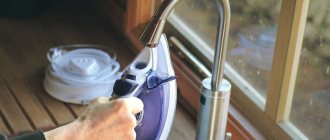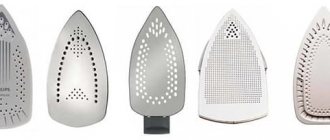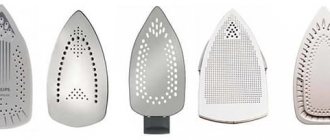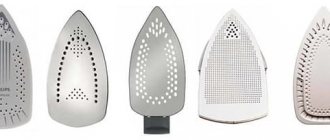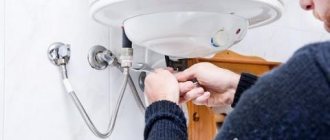- Special pencil
One of the most common problems with steam irons and steam generators is scale inside the device. Despite all the recommendations to fill the reservoir with distilled or purified water for irons, we, as a rule, use tap water. The result is a failed device. In this article we will talk about how to easily and quickly descale your iron at home.
To avoid scale build-up, use only purified water for irons and steam generators.
Before you use the following cleaning methods for a steam generator, you need to understand which model is in front of you. As a rule, steam generators come in two types:
- gravity;
- pump-type (working under pressure).
Pump devices are more efficient at steaming, but have a number of features. Cleaning such steam generators with improvised means at home can lead to damage to the device. It is better to use the services of a service center.
Gravity-flow models are not as effective, but less capricious in operation. They can be easily cleaned at home.
A steam generator is a more complex device than an iron and requires a serious approach. Use special descaling cleaners
What and how to wash the inside at home?
During the steaming process, water boils in the iron tank and, as a result, a coating of hardness salts (calcium and magnesium) forms on the heating element.
During operation of the device, sediment gradually accumulates and turns into hard scale , which interferes with the normal functioning of the device.
IMPORTANT! At the first signs of plaque and for preventive purposes, clean the electrical device once every 3-4 months.
This is interesting: 8 recipes for delicate cleaning of a Teflon iron.
Have you ever descaled your iron?
Not really
Hydrogen peroxide and soda - simple methods to combat mold
When you need to clean a container of water from mold, hydrogen peroxide will help remove green deposits from the bottom and walls, providing protection against new formations for the future. The antifungal agent works well against mold, is safe, and does not contain toxins.
Removing mold with peroxide is easy. To do this, pour it into a container for no more than 10 minutes, speed up the process with a narrow, hard brush.
A simple and safe remedy is baking soda. The product is safe, does not release toxins, has a gentle effect on the walls of the tank, delicately removing traces of mold. The advantage of this method is the ability of soda to absorb moisture, which prevents the formation of bacteria in the future. To clean, mix soda with water at the rate of ¼ tablespoon per glass of distilled water.
Effective folk remedies
Popular means for cleaning the device are products of the chemical industry - special powders and liquids that are sold in hardware stores.
You can remove limescale from the internal parts of the device without resorting to purchased products , but using traditional methods - food-grade citric acid, vinegar, carbonated water or hydrogen peroxide.
Lemon acid
The acid, entering into a chemical reaction with hardness salts, destroys their structure, turning scale into a soluble precipitate. During the reaction, carbon dioxide is released, which also helps soften the plaque.
Sequence of the procedure:
- prepare a basin or large bowl into which contaminated water from the appliance will flow;
- make a solution: add 25 g of citric acid to 200 ml of water, mix everything so that no grains of powder remain in the liquid;
- fill the cold iron reservoir with the product, close the lid;
- turn on the electrical appliance, set the regulator to the maximum temperature and wait until the device automatically turns off;
- turn off the power. Hold the iron horizontally over a basin or bathtub and press the steam release button. At the same time, gently rock the device from side to side;
- when all the liquid has come out of the appliance, refill the tank with an acidic solution and repeat cleaning until clean moisture comes out of the household appliance;
- wait until the device cools down, soak a cloth in water and wipe its sole, clean the holes with cotton swabs.
ADVICE! Fill the iron with clean water and do a test ironing on some unwanted fabric.
Vinegar
The method for cleaning the iron with this product is similar to the method using citric acid:
- pour water and 9% table vinegar into a small container (in a ratio of 3:1, respectively);
- pour the solution into the tank, if necessary, fill the steam outlet channels on the sole with it;
- turn on the electrical device (heating temperature is maximum), wait until the device turns off;
- then take the iron in your hands, place it over the basin and turn on the steam release function;
- if necessary, repeat the procedure several more times;
- Fill the tank with clean water, iron the unnecessary fabric;
- Wait until the device has cooled down and wipe the soleplate with a clean cloth.
In cases of severe contamination of the device, it is advisable to make the iron a “steam bath”:
- prepare a baking sheet or large frying pan with a thick bottom;
- in a separate container, mix a liter of warm water and 200 ml of table vinegar;
- Place the unplugged, cold iron on the bottom of the baking sheet. Place two sticks or pencils under the device so that there is a small distance between its base and the container;
- place the baking sheet with the iron on the stove, carefully pour in the solution (it should completely cover the sole, but not touch the body);
- turn on the stove; when the acidic liquid boils, turn it off immediately;
- after 30-40 minutes, bring the solution to a boil again, turn off the stove;
- After another half hour, remove the iron from the baking sheet, clean the soleplate and steam outlets with a rag, and rinse the tank.
IMPORTANT! After the “bath”, do not use the device for 24 hours. After this time, turn on the device and iron and steam an old item (preferably made of cotton fabric).
FYI: 3 easy ways to clean a microwave with vinegar are presented here.
Sparkling mineral water
Carbonation of soft drinks occurs by saturating the liquid with carbon dioxide. If you use mineral or regular carbonated water to remove plaque, this substance is released when heated and interacts with the scale.
As a result of a chemical reaction, calcium bicarbonate is formed - a soluble salt that easily comes out of the iron along with steam:
- prepare an old towel or other thing made from natural fabric;
- fill the device reservoir with soda;
- turn on the device, set it to maximum heat;
- iron the fabric using steam;
- if necessary, repeat the procedure 3-4 more times.
ATTENTION! For cleaning, it is advisable to use sparkling water that does not contain dyes.
Peroxide
With the help of this drug you can effectively get rid of rust and plaque in many household appliances, including iron:
- place the switched off device vertically;
- soak a cotton pad in the preparation and thoroughly wipe the heating element of the device, removing plaque and other contaminants;
- Also soak cotton swabs in peroxide and clean the holes and steam exit channels.
ATTENTION! The iron does not need to be preheated before performing this procedure.
If regular wiping does not help remove scale, the following method can clean the device:
- soak a piece of linen or cotton material in peroxide;
- place the fabric on the soleplate of a cold iron standing vertically;
- After 2 hours, wipe the heating element with clean water and iron any unnecessary material.
How to clean an iron with a steam generator from scale using the self-cleaning function
Self-cleaning, which is provided in some models, helps to effectively remove scale from the iron. Use it as follows:
- Distilled water is poured into the tank to the maximum mark on the scale;
- The device is turned on to maximum heat and waits for automatic shutdown;
- steam supply is set to the minimum level;
- the iron is held over a wide basin and a special button is pressed, which activates self-cleaning;
- wait until the dirty water pours into the substituted tank.
Finally, the device is lightly shaken several times, unplugged and placed vertically. When the device has completely cooled down, the liquid reservoir will need to be rinsed with plain water, and the sole will need to be wiped dry with a soft cloth.
Specialty purchased chemicals
Preparations used to clean irons allow you to quickly, efficiently and carefully remove scale from the internal and external parts of the device without damaging the non-metallic elements of the device.
Antiscale
One of the most popular products designed for cleaning household appliances from plaque at home:
- add half a teaspoon of the drug to 200 ml of water, mix the ingredients;
- pour the solution into the iron tank;
- heat the device to maximum temperature, unplug it, place it vertically;
- after 30 minutes, holding the device horizontally over a basin or sink, release steam, along with which softened particles of lime deposits will come out.
IMPORTANT! After the procedure, refill the iron with clean water, heat it and iron the unwanted fabric.
Top house
Use the German drug according to the following scheme:
- mix 50 ml of product and 100 ml of water;
- pour the solution into the iron and place the device in a vertical position;
- turn on the device, after heating, disconnect it from the network;
- place the iron horizontally for 10 minutes (on a special stand or table, after placing slats or pencils under the hot sole);
- After the specified time has passed, place the device over a sink, bathtub or basin and, shaking the equipment, release steam.
Cillit bang
- the product, as in the previous case, mix 50 ml with 100 ml of water and fill the iron reservoir with the solution;
- Heat the device, turn it off, place it horizontally for 10-15 minutes, then press the steam release button.
Pencil
A chemical product in the form of a pencil allows you to effectively remove not only scale, but also get rid of old and fresh carbon stains on the sole:
- fill the iron with water, turn it on (heating temperature – at least 120 ⁰С);
- after the device automatically turns off, turn off the power and rub the hot sole with a pencil;
- iron the old fabric with steam, cleaning the heating element from dirt and chalk residues.
IMPORTANT! The procedure is accompanied by the release of a pungent odor, so before starting work, open the windows in the room and work with rubber gloves.
Cleaning accessories
Some models have a special self-cleaning system. For this purpose there is a special button located on the body of the device. According to the manual, heat the device to the required temperature. To start the cleaning process, press the button.
With such a system, any housewife will be able to clean the device without effort.
If rust and scale are not washed out of the iron, it is disassembled and all parts are washed manually. If you do not completely trust your knowledge of technology, it is better to entrust this activity to a professional.
Embedded Systems
Most iron models are equipped with built-in self-cleaning functions and anti-limescale systems.
Self-cleaning function from scale and rust
Perform the operation at least once every 2 months:
- prepare a container to drain dirty liquid from the iron;
- fill the tank with water;
- turn on the household appliance at full power, wait until it turns off automatically. Turn the device back on;
- When the iron turns off, place it in a horizontal position over your pelvis.
- press the self-cleaning button (“Calc Clean”): at the same time, steam with particles of plaque, rust and other contaminants will begin to emerge from the sole of the device;
- repeat the entire procedure 3-4 more times (until the device is completely clean);
- wait for the iron to cool completely, remove any remaining scale from the soleplate and the holes on it.
IMPORTANT! After self-cleaning, perform the first ironing on the old item.
Anti-scale system
Steam generators and many models of irons with a steam function are equipped with additional devices that allow you to soften the water used to operate the devices: cassettes or anti-lime rods.
Cassettes can be replaceable (after a certain service life of the iron, they must be replaced with new ones) and permanent (valid throughout the entire service life of the iron).
Anti-lime rods are designed to last the entire “life” of a household appliance, but they also need to be periodically descaled (at least once every 2 months):
- remove the rod from the iron;
- make a solution of citric acid (2-3 tablespoons of powder per glass of water) or mix table vinegar and water in equal parts;
- Place the rod in an acidic liquid for 2 hours, then rinse the device with clean water and place it in its original place.
Features of internal cleaning
Brown liquid flows out of the iron
If the iron spits rust, this may be due to the internal elements of the silicone steam generator becoming unusable. These parts are gaskets between the water tank and the base of the device.
- During prolonged use, the sole becomes hot. At the right time, the thermostat, which turns off the iron to prevent excessive overheating, does not work.
- The metal heats up to such an extent that it begins to affect the insulation of the silicone steam generator chamber.
- At a heating surface temperature of about 300 degrees, even heat-resistant silicone material melts.
- The iron begins to spit out brownish liquid. This is not rust, but molten silicone, similar in color to it.
It is necessary to replace a thermostat that has stopped working. The new unit will allow you to get rid of excessive overheating of the metal elements of the iron. If this is not done, the device may become unusable.
Real rust occurs not only due to poor quality water, but also due to a violation of the insulation of metal elements from moisture inside the steam generator chamber. If they are corroded, there is no point in repairing the device. If it’s just a matter of rusty or moldy stains due to bad water, the iron can be used quite well after proper cleaning.
Steam generator care
There are two types of steam generators:
- gravity-flow device (water flows to the heating element of the iron, where under the influence of high temperature it turns into steam);
- pump device (liquid is heated in a special container, converted into steam, which passes under high pressure to the sole of the iron).
ATTENTION! If your household appliance is a pump type, it is advisable to have it cleaned at a service center.
In gravity-fed units, in the absence of chemicals, you can remove scale using home methods:
- add 2 tablespoons of citric acid to 1 liter of water, pour the solution into the steam generator tank. Turn on the device and iron the unnecessary material;
- fill the liquid container of the device a quarter of the volume with vinegar, turn on the equipment. Release steam on the old material until all the vinegar is used up.
Prevention measures:
- periodically clean the internal and external surfaces of the device, wipe the sole with a cloth after each use of the device;
- store household appliances in an upright position, in a closed box;
- use only soft purified water for work;
- After ironing, always drain the water and press the steam button several times.
The best way to combat plaque is to follow the operating rules of the ironing tool and regularly clean its internal and external surfaces using the built-in function, special or improvised means.
Hydrogen peroxide and soda - simple methods to combat mold
When you need to clean a container of water from mold, hydrogen peroxide will help remove green deposits from the bottom and walls, providing protection against new formations for the future. The antifungal agent works well against mold, is safe, and does not contain toxins.
Removing mold with peroxide is easy. To do this, pour it into a container for no more than 10 minutes, speed up the process with a narrow, hard brush.
A simple and safe remedy is baking soda. The product is safe, does not release toxins, has a gentle effect on the walls of the tank, delicately removing traces of mold. The advantage of this method is the ability of soda to absorb moisture, which prevents the formation of bacteria in the future. To clean, mix soda with water at the rate of ¼ tablespoon per glass of distilled water.
Preventing scale formation
To avoid scale formation, you need to follow simple recommendations:
- do not leave water inside the iron;
- Dry the device thoroughly after using the steam function;
- use a water softener or install a special cleaning system, such as magnetic filters;
- dilute ordinary distilled water 1:1;
- After ironing, wipe the soleplate of the iron dry.
Experienced cleaners know these simple rules and follow them while working. Book a spring cleaning and see for yourself.

